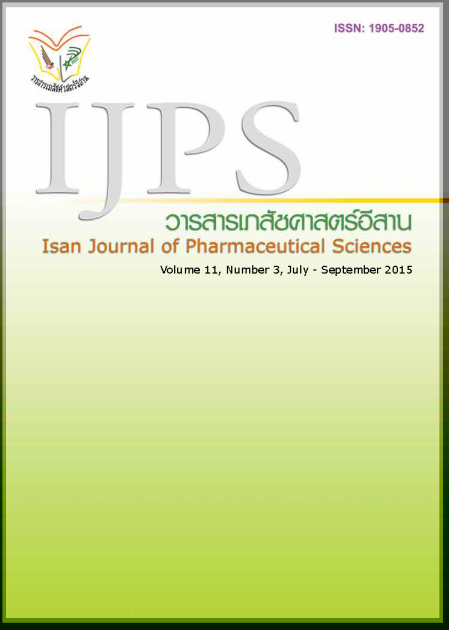Stability Assessment of Extemporaneous Captopril Oral Suspension
Main Article Content
Abstract
The aim of this study was to test the stability of extemporaneous captopril oral suspension (1 mg/ml) stored in light-resistant containers. Methods: The physical and chemical stability was assessed in those suspension stored at room temperature (25-28°C) compared to those at the refrigerated temperature (2-8°C). The samples were tested on day 0, 7, 14, 21, 28. Results: The physical characteristics including color, sedimentation and redispersibility of captopril oral suspension were unchanged in all conditions through day 28. The chemical characteristics were measured by pH alteration and the remaining drug content analyzed by reversed phase HPLC. The acceptable range of remaining drug content, based on USP criteria, was 90-110% of the initial content. At room temperature (25-28°C), remaining drug content in suspension was out of the acceptable range. At the refrigerated temperature (2-8°C), remaining drug content in suspension stored was in the acceptable range (90-110%) through 14 days.The pH of extemporaneous captopril oral suspension was found to be less than 4. Conclusion: At the refrigerated temperature (2-8°C), extemporaneous captopril oral suspension was stable for 14 days that remaining drug content was in the acceptable range. The result from this research can help hospital pharmacists to effi ciently assign the shelf life and storage conditions of extemporaneous captopril oral suspension.
Article Details
In the case that some parts are used by others The author must Confirm that obtaining permission to use some of the original authors. And must attach evidence That the permission has been included
References
Berger-Gryllaki M, Podilsky G, Widmer N. The development of a stable oral solution of captopril for paediatric patients. The European Journal of Hospital Pharmacy Science 2007; 13(3):27-32.
Glass BD, Haywood A. Stability considerations in liquid dosage forms extemporaneously prepared from commercially available products. J Pharm Pharm Sci 2006; 9(3): 398-426.
International Conference on Harmonisation (ICH) expert working group. ICH harmonized tripartite guideline. Validation of analytical procedures: text and methodology Q2(R1). Commission of the European Communities; 1996.
Kay JD, Colan SD, Graham TP. Congestive heart failure in pediatric patients. Am Heart J 2001; 142: 923-8.
Kristensen S, Lao YE, Brustugun J, Braenden JU. Infl uence of formulation properties on chemical stability of captopril in aqueous preparations. Pharmazie 2008; 12 (63):872-877.
Leonard G, Corey F, Corey H. Hypertension in childhood. PediatrRev 2007; 28: 283-298.
Lye MY, Yow KL, Lim LY.Effects of ingredients on stability of captopril in extemporaneously prepared oral liquids. Am J Health-Syst Pharm 1997; 53: 2483-2487.
Patel VP, Desai TR, Chavda BG, Katira RM. Extemporaneous dosage form for oral liquids. Pharmacophore 2011; 2(2): 86-103.
Pramar Y, Das GV, Bethea C. Stability of captopril in some aqueous systems. J Clin Pharm Ther 1992; 17: 185-189.
Supattanakul P, Apiromrak P, Ovatlarnporn C. The stability ofancaptopril oral solution prepared from tablets. Songkla Med J 2006; 24(3): 183-190.
The United States Pharmacopeia (USP) 36 and The national formulary (NF) 31, Asian editon Volume 2. Rockville: USP Convention Inc; 2013.
Vimolsarawong N. Extemporaneous compounding of oral liquids for pediatrics. Thai Pediatr J 2012; 19(3): 193-199.


